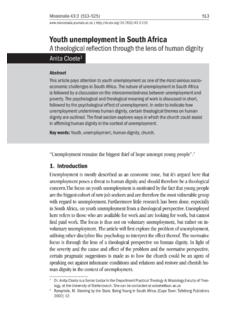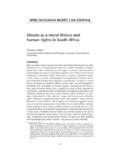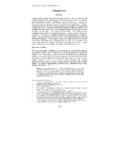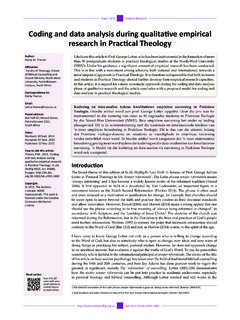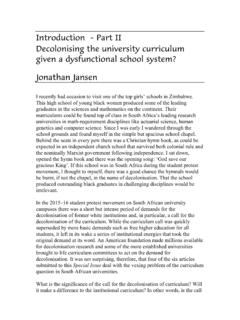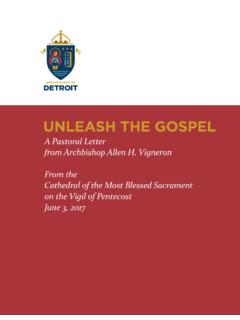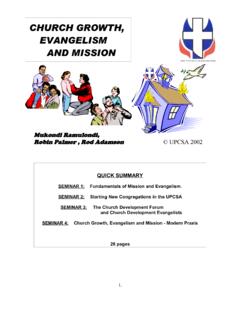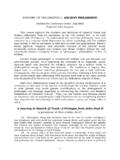Transcription of The impact of apartheid on the educational …
1 Studia Historiae Ecclesiasticae, October 2010, 36(2), 167-185 The impact of apartheid on the educational endeavours of two missionary agencies Frederick Hale Department of English, University of Stellenbosch, Stellenbosch, South Africa Abstract Numerous studies have shown how apartheid and the struggle against it influenced a range of Christian denominations and missionary agencies in South Africa, but these investigations have tended to ignore smaller denominations and missions. This article focuses on two of these denominations and missions: the Norwegian Mission Covenant and the Scandina-vian Alliance Mission of North America (after 1949 called The Evangelical Alliance Mission).
2 Both were historically rooted in the premillennial revivalism of the Swedish-American evan-gelist Fredrik Franson. Their missionary workers reacted in various ways to the pressures that increased social engineering along racial lines put on their work among black South Afri-cans. The Bantu Education Act of 1953 removed one of the pillars of their outreach programme education. Some of their missionaries vigorously criticised apartheid , while others assumed a more passive attitude. This article also discusses the role of their eschatology and the rural/urban emphasis in their ministries in influencing their responses to apartheid .
3 Introduction Decades of scholarly analysis have shed a great deal of light on how South African churches participated in earlier racial segregation and how they reacted to the implementation of apartheid after 1948. Since the publication, in 1979, of John de Gruchy s seminal The church struggle in South Africa,1 a handful of other South African and foreign scholars have also explored the parallel reactions of various Christian bodies to the overarching racial quan-dary in which South African society found itself. Prime examples of efforts to redress decades of neglect are Garth Abraham s study of the Roman Catholic Church s mixed record in confronting the implementation of 1 John W.
4 De Gruchy, The Church Struggle in South Africa (Grand Rapids: William B. Eerdmans Publishing Company, 1979). The impact of apartheid on the educational endeavours of .. 2apartheid2 and Michael E Worsnip s corresponding analysis of Anglican One significant historiographical trend during both the disillu-sioning decade of the1980s and the watershed 1990s was the insistence that not only the Afrikaans denominations, but also the so-called English-speaking churches (many of which were, in fact, multilingual and had a majority of black members), which hitherto had been widely regarded as prophetic voices calling for social and political justice, contributed to the maintenance of racial segregation and white hegemony in South Africa.
5 Particularly notable were detailed studies by James R Cochrane4 and Charles Villa-Vicencio,5 both of whom cogently challenged the prevailing view of various churches role in opposing apartheid . The impact of apartheid on many dimensions of the country s complex history of missionary endeavours, however, is less well documented. This article addresses the impact of certain racial dimensions of the National Party s educational policies on two Scandi-navian and Scandinavian-American missionary agencies, about which little of a scholarly nature has hitherto been published. In Southern Africa, legislation concerning race relations first bedevil-led missionary outreach in the nineteenth century, first in the rural areas, such as Natal and Zululand, and then in the cities and townships, after indigenous Africans flocked to Kimberley, Durban, the Witwatersrand, and other indus-trialising and mining areas in search of employment and increasing numbers of missionaries followed them in order to conduct evangelisation pro-grammes and other forms of ministry.
6 Several decades later, the accession of the National Party to power in 1948 and the gradual implementation of its apartheid policies posed further challenges to missionaries, not least to those from overseas, who resided temporarily in the Union of South Africa at the pleasure of its internationally beleaguered government. Initially, many of these men and women criticised apartheid , as did their sponsoring organisa-tions although, during the 1950s, the legally vulnerable missionaries in South Africa generally accommodated apartheid and accepted, however grudgingly, measures such as the Bantu Education Act of 1953, which effectively com-pelled them to surrender most of their schools to the control of the government.
7 As I have argued elsewhere, this was clearly the case of the Church of Sweden Mission, which had been active in Natal since the 1870s and which, 2 Abraham, Garth, The Catholic Church and apartheid (Johannesburg: Ravan Press, 1989). 3 Michael E. Worsnip, Between the Two Fires: The Anglican Church and apartheid , 1948-1957 (Pietermaritzburg: University of Natal Press, 1991). 4 James R. Cochrane, Servants of Power: The Role of English-speaking Churches in South Africa (Johannesburg: Ravan Press, 1987). 5 Charles Villa-Vicencio, Trapped in apartheid : A Socio-Theological History of the English-Speaking Churches (Maryknoll, New York: Orbis Books, and Cape Town: David Philip, 1988).
8 The impact of apartheid on the educational endeavours of .. 3 from the very beginning of the twentieth century, had operated extensive ministries in Johannesburg and across much of the Witwatersrand. The apartheid system of social engineering along racial lines squarely contra-dicted the egalitarian vision of the Scandinavian welfare states and the sensi-tivities of large numbers of Swedes, Norwegians, and others in the wake of the Second World However, the Church of Sweden Mission and its counterpart, the Norwegian missionary Society, were by no means the only Scandinavian (or Scandinavian-American) missionary agencies then operating in the Union of South Africa.
9 Among others were the Norwegian Mission Covenant, the Swedish Holiness Union, the Swedish Free Baptists, and the Scandinavian Alliance Mission of North America, all of which had been active in the region since the late nineteenth century. To date, relatively little of a scholarly nature has been published about the history of the endeavours of these societies in South Africa. In this article I shall examine how two of them, namely, the small denomination called the Norwegian Mission Covenant (hereinafter abbreviated DNM, for Det Norske Misjonsforbund) and the much larger Scandinavian Alliance Mission of North America (SAMNA, and its successor, The Evangelical Alliance Mission, or TEAM), a non-denominational, para-church organisation (which was then or had been active in not only South Africa, but also China and other countries) responded to the new paradigm in official race relations that began in the latter half of the 1940s.
10 The two eschatologically inspired missions The roots of both missions lay in the intercontinental evangelisation initiated by the Swedish-American Fredrik Franson. Born in Sweden in 1852, Franson emigrated to the United States of America while still a teenager and, although lacking formal training in theology, joined the staff of the increasingly well-known evangelist Dwight L. Moody in Chicago, at whose church Franson ministered to Scandinavian immigrants. During this time Franson came under the influence of futurist millenarianism (or premillennialism), popularised on both sides of the Atlantic by the Irish Protestant, John Nelson Darby. Also known as dispensationalism , this branch of eschatological thought postu-lated that none of the biblical prophetic events pertaining to the Second Coming of Jesus Christ had yet occurred but that his return, initially in the secret rapture , could be expected at any time.
